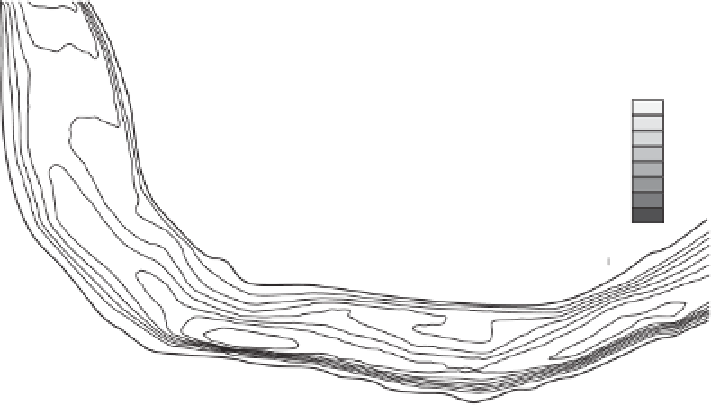Environmental Engineering Reference
In-Depth Information
11.3.4 Simplifying interactions
suite of models discussed in Chapter 4). Such models
tend to use cellular definitions of processes and employ
rule-based approaches to consider local interactions of
water, topography and other parameters, rather than to
solve sets of equations over the entire domain of interest.
Often these approaches are interested in the longer term
feedbacks and thus on landform evolution (see Section
11.2.8 and Chapter 19).
Nicholas (2009) has compared the behaviour of such
reduced-complexity approaches to traditional applica-
tions of the shallow-water equations (see Chapter 6).
Figure 11.10 shows the similarity between the amount and
As also seen in Chapter 6, there are large computational
overheads in using detailed representations of flow
equations. These overheads have typically contributed
to the simulation of limited flow domains and thereby
emphasized reductionist approaches to catchment
hydrology. Some work is currently underway to use
massively parallel computers to address these issues.
An alternative is to use simpler models that still retain
detail of interactions - so-called reduced-complexity
models (the example from Wainwright, 2006, discussed
above, falls into this definition, as does the RillGrow
0
0-1
0-2
0-3
0-4
0-5
0-6
0-7
0
20 m
0
20 m
(a)
0
0-1
0-2
0-3
0-4
0-5
0-6
0-8
0
20 m
0
20 m
(b)
Figure 11.10
Simulation of flow round a single meander bend: a. using the shallow-water equations (see Chapter 6 for further
details); and b. using a reduced complexity approach. The pairs of figures show the magnitude of unit discharge (smaller inset) and
its vectors in the
x
and
y
directions (Modified with permission from Nicholas, A.P. (2009) Reduced-complexity flow routing models
for sinuous single-thread channels: intercomparison with a physically-based shallow-water equation model.
Earth Surface Processes
and Landforms
, 34, 641-53).


















































































































































































































Search WWH ::

Custom Search